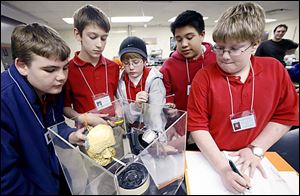
Area students probe effects of 2nd-hand smoke
4/12/2006
Troy Favorite, from left, Kyle Hatfield, Andrew Newmyer, Nick Sebeda, and Nicholas Schmidlin work on a smoke experiment. The students are working in a laboratory at Bowling Green State University as part of their study.
As four Sylvania Franciscan Academy students pulled on latex gloves, medical student Theresa Frey spelled out some rules: Don't squeeze the hearts or the lungs. Don't rip off valves or blood vessels. Do be respectful of the donated body parts.
Charles Never of Toledo, one of the sixth-grade students participating in a study on the effects of second-hand smoke, gingerly touched a lung.
Taking a deep breath, he picked up the organ in a classroom at Medical University of Ohio. "This is awesome," he said.
Students asked questions, jotted down notes, and soaked up information provided by Miss Frey of Toledo as part of a field day experience.
Other students from the academy visited the Sylvania mayor's office, restaurants, a bowling alley, and Bowling Green State University as they investigated the effects of environmental tobacco smoke in the community.
The investigation centers around a simulated scenario in a bowling alley where a fictitious student has an asthma attack.
"We're trying to figure out what caused his asthma attack," said Joseph Habib of Sylvania as the students used stethoscopes to listen to each other's hearts and lungs. "We have to gather our facts."
At this point, they believe the attack was triggered by second-hand smoke.
Abby Moore of Holland and Laura Earl of Sylvania agreed that the study is interesting and said they've learned a lot about the effects of second-hand smoke.
Other students are investigating and researching the composition of environmental tobacco smoke, indoor-air-quality issues, the process involved in enacting smoking bans, and civil liberties.
As part of the study, students have the opportunity to test various environments for indoor air quality, interview the general public on issues related to smoking bans, tour pulmonary doctors' facilities, test filter systems, visit with governmental officials to learn how laws are proposed and enacted, and study the economic effects of smoking regulations on businesses.
During the students' visit to Sylvania Mayor Craig Stough's office, they asked him about smoking bans, and the mayor said, "We feel a statewide ban is more appropriate than one just for the city, and the state legislature has taken that to heart."
When students asked if he believed that most Sylvania residents would support a smoking ordinance, he replied yes but said, "It is the city's responsibility, and particularly mine, to preserve the rights of everybody and not necessarily force one person's point of view on another."
If a smoking ban were enacted for Sylvania, the mayor said, it should have a provision allowing a business to post on its door that it is a smoking establishment. That way, customers could decide whether to go in.
The students' study is made possible through Project EXCITE, a $1.8 million, seven-year professional development project funded by the National Institute of Environmental Health Sciences.
Based at BGSU, the project's goal is to use locally relevant environmental health science topics to engage students in valuable learning experiences across multicurriculum disciplines, according to Roberta Handel, media specialist and librarian at the Sylvania Franciscan Academy who is on the project team with Bernie Thompson, Marlene Wainer, and Susan Bastian. Students from all over Toledo, its suburbs and Michigan attend the academy.
Teachers selected the study topic because it is "very much a concern everywhere," Mrs. Handel said, and, it's "an environmental issue that is very tangible for kids."
The sixth-grade students' three-week study will culminate in presentations May 10 during the 2006 Project EXCITE colloquium at COSI.
Several schools in northwest Ohio have participated in the project in the last few years and students have explored topics including water quality, food safety and contamination, and bridge construction over the Maumee River.
Contact Janet Romaker
at jromaker@theblade.com
or 419-724-6006.